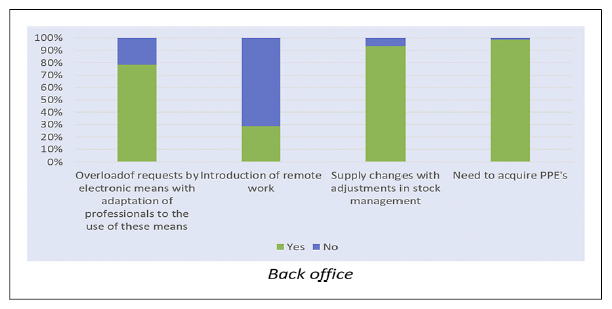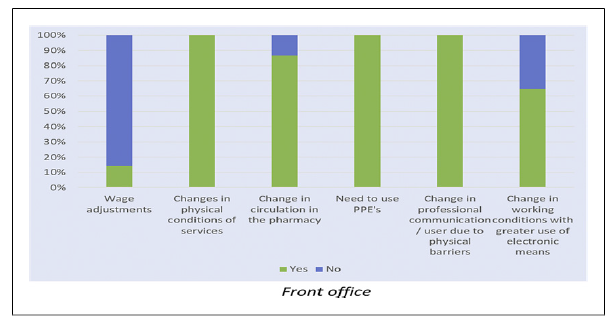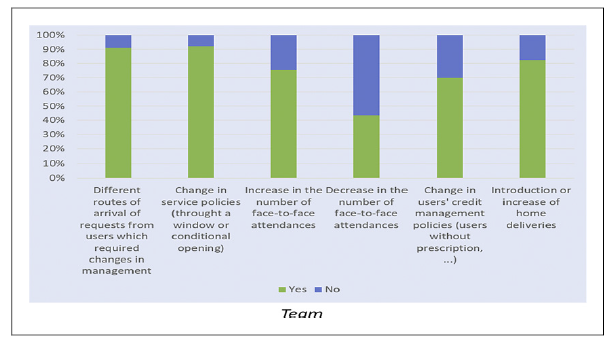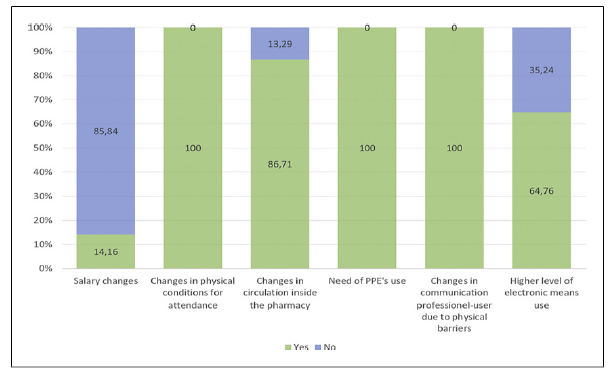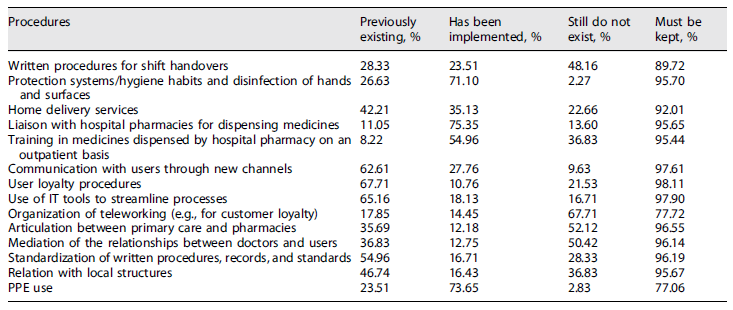Introduction
Community pharmacy (CP) professionals (namely, pharmacists, technicians, and auxiliary staff) were, along with physicians and nurses, the health professionals who experienced a higher risk of contact with SARS-CoV-2 1. After the declaration of the pandemic and the State of Emergency in Portugal, CP professionals were among the essential services that continued to function and were among the first to quickly adopt preventive measures to reduce the risk of contamination, which has been highlighted by several authors 1-4. Adding their typical activities to the CP professionals beyond their usual functions played a crucial role in minimizing community contamination and promoting community education regarding the new reality and how to exercise control and remain safe 3. To achieve these goals, the services most frequently implemented by CP professionals included reservation/delivery of medicines at home and the implementation of telephonic/electronic counseling. In fact, one of the toughest challenges was the reduction of direct contact between professionals and users, and the consequent higher risk of drug misuse, especially in more vulnerable users 5. Being proximal to the community, the CP professionals have also become a reference service for obtaining information about COVID-19, especially in demystifying doubts and fears arising from the poor quality of news conveyed by traditional media and social networks 2.
Confronted with such sudden and disruptive changes, CP professionals and their teams have generally shown enormous adaptability and resilience 6. However, due to the increase in professional challenges in addition to personal and family demands, these professionals experienced, at that time, severe psychosocial risks for the development of physical and psychological disorders. Thus, their experiences should be widely acknowledged and considered to better prepare future professionals to deal with similar situations 4,5,7,8.
It is generally agreed that CP professionals have a fundamental role in the health community 9,10. The COVID-19 pandemic confirmed this once again 11.
Objectives
The three main objectives of this research were (i) to describe the changes implemented at the organizational level in the CPs in the context of the COVID-19 pandemic; (ii) to understand the perceptions of CP professionals regarding their experience during the COVID-19 pandemic, namely, at the relational level (peers and with users) and intrapersonal (namely, the personal and family dimension); and (iii) to explore what participants gained in terms of knowledge and changes in their professional practice that should continue for such professionals after the pandemic.
Methods
Study Design
An observational, descriptive, and cross-sectional study was carried out. An online questionnaire was implemented and disseminated through the researchers’ professional/social networks - specific professional groups with national scope (answers were collected via Google forms). The sampling technique used was a snowball, obtaining a non-probabilistic convenience sample of 353 participants.
The target population consisted of professionals working in CP in Portugal, who agreed to participate in the study and who met the following inclusion criteria: to have participated in an activity in CP for more than 2 years and to have developed professional public assistance during the initial phases/emergency stages of the COVID-19 pandemic in the pharmacy.
The study was carried out in five sequential phases between June and September 2020. Phases 0-2 were focused on the development of the tool (a questionnaire) to be later used; in phase 3, the questionnaire was disseminated online, and in phase 4, collection, validation, processing, and analysis of the data were performed.
Development of the Survey Tool
Phase 0 - Review of literature and elaboration of a guide to be used in panel of experts:
Invitation to a group of CP professionals (pharmacists and technicians) distributed geographically through Portugal to integrate an expert panel
Phase 1 - Collaborative development of the questionnaire:
Development, by the research team, of a proposal for a questionnaire based on the scientific literature and on the researchers’ experience, considering the objectives of the study
Submission of the proposal to the expert panel of CP professionals (constituted by 10 representatives of the professional groups that work in CP - pharmacists and pharmacy technicians)
Request each expert to send their comments on the proposed questionnaire
Compilation of the expert contributions
Organization of two Zoom meetings with the expert panel for the discussion of the final questionnaire version
Phase 2 - Development of the final version of the questionnaire and preparation of the online form
The final questionnaire, in addition to the sociodemographic and professional characterization of the participants, explored six dimensions, defined during the expert panel meeting:
Management and organization: this dimension refers to the participants’ perceptions regarding organizational changes that took place during this period.
Work conditions: this dimension asked for the participant’s perception of changes concerning the workplace (e.g., physical conditions of the pharmacy), the economic aspect of work, and the personal protective equipment (PPE) required for the continued operation of the pharmacy.
Interpersonal atmosphere: this dimension was intended to understand the participants’ perceptions about the quality of teamwork and interaction.
Relationship with users: in this dimension, it was intended to understand the participants’ perception of their interaction with the clients.
Personal experience: this dimension was intended to understand the emotional experience, including negative emotions, namely, psychological exhaustion; anxiety; depressive symptomatology; increased levels of anger; positive emotions, such as job satisfaction, personal satisfaction, solidarity, motivation, and gratification; and symptoms of physical disturbance, including physical exhaustion, sleep problems, and eating problems experienced by the participants.
Learnings for the future: in this dimension, participants were asked to highlight the main lessons learned during this period in terms of CP organization and procedures.
Information was also collected regarding stress/stressors, as well as the professional needs felt to be the most stressful by the respondent during this period. A Likert scale with 5 or 3 response options was used, along with some open questions. The CHERRIES - checklist for reporting results of internet e-surveys - has been filled out, ensuring compliance with the methodological principles of this type of study 12.
Ethical Proceedings
Informed and enlightened consent was requested from the participant prior to any data collection, and the questionnaire was anonymous. This study respects the principles of the Declaration of Helsinki and the General Regimen of Data Protection. The study was approved by the Ethics Committee of the Lisbon Health Technology School (CE-ESTeSL n. 57-2020).
Results
A total of 353 professionals responded, mostly female (84.1%), pharmacists (81.3%), aged between 21 and 66 years (mean = 37.6), and an average time of activity in CP of 12.9 years. Of these, 55.5% reported having had as their predominant activity during the pandemic service at the counter and 34.8% service at the hatch.
Regarding geographic distribution, most worked in a predominantly urban environment (75.0%) and in the Lisbon and Tagus Valley region (54.7%). The participation of respondents from all national regions is highlighted: North (15%), Center (12.5%), Alentejo (6.8%), Algarve (7.4%), and Azores and Madeira (3.68%). Among the measures taken by CP professionals during the pandemic, the one most frequently mentioned by participants was the reduction of working hours (46.2%), followed by shift work (6.2%), with only 2% resorting to simplified layoff.
Dimension: Management and Organization
Figures 1-3 present the changes that occurred in the management of the pharmacies, both in the “back office,” the “front office,” and within the pharmacy “team.” According to Figure 1, the most frequent changes in the back office were related to the inventory of the pharmacy, requiring adaptation of stock management (93%), and the need to purchase PPE (99%).
At the “front office” level (Fig. 2), the changes were reported to be significant, the most frequent being the change in service policies (introduction of shuttered or conditioned openings-92.2% of cases) and different user order receiving paths, demanding changes in the management of these requests (91.1%). Regarding the “team” (Fig. 3), changes were less reported, with only one reaching 100% of the reports - the change in personal safety measures. Additionally, noteworthy was the introduction or increase in home delivery (82% of cases). When responsible persons, managers, or owners were asked about the main changes in aspects of management during the pandemic, the most often reported were the need to adapt to frequent legislative changes (90%) and fluctuations in treasury, finance, and stocks (81.5%).
Dimension: Working Conditions
Regarding the working conditions dimension (Fig. 4), the report of salary changes was infrequent, but physical changes (e.g., counter service conditions) affecting professional/user communication and providing greater recourse to the use of electronics were mentioned by 100% of the participants. Regarding organization and procedures, participants were also asked about a set of procedures and training used during this period, previously identified in the literature review and by the group of experts (14 items). The implementation was questioned, as well as the expectation/potential for maintaining the procedures after the pandemic (Table 1).
The procedures that were most frequently implemented were, as expected, the use of protection systems and PPE but also, and significantly, the articulation with hospital pharmacies for dispensing drugs in proximity (75.3%), as well as training in this specific area (55.0%). There was also a significant increase in the offer of home delivery in written procedures for the transfer of shifts and communication with users through new channels.
When asked which ones should be maintained after the pandemic, more than 70% of the sample responded positively to all newly implemented changes; however, those who obtained positive responses above 95% were the maintenance of protection systems, articulation with hospital pharmacies for dispensing medication and respective training, communication with users through new channels, user loyalty procedures, the use of computer tools to streamline processes, linking primary care to pharmacies, mediating the relationship between the user and the physician, the standardization of written procedures, and the relationship with local entities and structures. The professionals reported added value in CP functioning in a network with other parties, whether in healthcare or elsewhere in the community; they value these relationships and support their maintenance in the post-pandemic. In the participants’ experiences, four dimensions were considered: interpersonal climate (intrateam relationship), relationship with the user (interaction), personal experience (emotional, somatic, and life changes), and stress/stressor (identification of sources).
Dimension: Interpersonal Climate within the Team
Regarding relational aspects, most participants reported that there was no change in the quality of interaction within their team. A high percentage of participants referred to improvements in work relations, namely, increased mutual help (57.2%), increased solidarity (54.3%), and group cohesion (49.9%). Increases in the force of attraction within the team may have acted as an individual protective factor and a promoter of collective stability, allowing for the maintenance of productivity and reducing the risk of psychological disturbance.
Dimension: Relationship with Clients
Data showed that many participants reported an increase in the client’s needs and requirements. Highlighted as more significant are the replacement of the habitual user by third parties (e.g., family relatives) to whom he delegated that task (70.8%); the change in communication channels (e.g., the increased use of technological means) (68.3%); and changes in communication due to security measures (e.g., face masks) (48.4%). A smaller number indicates the increased connection between CPs and other health institutions (e.g., healthcare centers or hospital pharmaceutical services) as a factor that promoted improvement of the relationship with the user (15.6%).
Dimension: Personal Experience
This dimension was introduced with the request for a general evaluation of the emotional experience through the question, “Was the experience during this period emotionally…?” -in a 10-point visual analog scale (1 - “Much less demanding than usual” and 10 - “Much more demanding than usual”). The average obtained was 8.92 (±1.18).
Regarding the perceived degree of emotional demand experienced in this period, this average is much higher than the average value (5), showing that, in general, the participants considered that the experience was challenging for their emotional balance. Regarding negative emotions, most of the participants referred to physical (66.3%) and emotional (59.8%) exhaustion. A significant number reported anxiety (47%). These results highlight the negative emotional and physical impact of the experience on these professionals. Regarding positive emotions, professional aspects were highlighted (e.g., satisfaction of the job completed 75.6%) and altruism (e.g., solidarity 71.1%), showing the importance attributed by CP professionals to their role of outreach and community support. The expressive frequency of positive emotions of gratification (42.5%), reinforcement (49.3%), and motivation (43.3%) were also highlighted. These may have served to offset negative emotions.
Regarding somatic symptoms, participants reinforced the experience of a threat over which the participants felt they had little control. Thus, many reported anxiety (46.2%), increased irritability (42.2%), and sleep problems (31.4%).
When asked about the impact of the experience in the professional context on their personal lives, most of the participants pointed to the “lack of time to take care of themselves” (69.4%), the “changes required in family functioning” (62.1%), and the “difficulties in organizing daily tasks” (49.4%). A high number of participants emphasized the “loss of quality in providing support to other people in their charge” (40%). Although the majority considered that the quality of the family environment did not change, a significant number reported “the loss of quality in family relations” (47%), proving the widespread disturbance associated with living in this period.
Dimension: Learnings about Organization and Procedures for the Future
In this dimension, a list of affirmations and an open-ended question were used to explore lessons for the future around organization and procedures. The implementation was questioned, as well as the expectation/potential for their maintenance after the pandemic (Table 1).
The procedures most frequently implemented were, as expected, the use of protection systems and PPE but also, and very significantly, the articulation with hospital pharmacies for dispensing drugs in proximity (75.3%), as well as training in this specific area (55.0%). There was also a significant increase in the offer of home delivery in the existence of written procedures for the transfer of shifts and communication with users through new channels.
When asked which ones should be maintained after the pandemic, more than 70% of the sample responded positively to all; however, those who obtained positive responses above 95% were the maintenance of protection systems, articulation with hospital pharmacies for dispensing medication and respective training, communication with users through new channels, user loyalty procedures, the use of computer tools to streamline processes, linking primary care and pharmacies, mediating the relationship between the user and the physician, the standardization of written procedures, and the relationship with local entities and structures. The professionals felt the added value of the functioning of CP in a network with other structures, whether health or local, and that they valued this relationship, noting the importance of its maintenance in the post-pandemic. In the participants’ experience, four dimensions were considered: interpersonal climate (intrateam relationship), relationship with the user (interaction), personal experience (emotional, somatic, and life changes), and stress/stressor (identification of sources).
Discussion
Several recent publications have already highlighted the extraordinary efforts community pharmacists across the world have made in stepping up to support their communities 4,13,14. To minimize the needed efforts and be more effective in possible future pandemics, the preparedness of community pharmacies will be essential 15. This study provides important insights based on participants’ own experiences (pharmacy professionals) regarding the means that have been implemented in the COVID-19 pandemic in Portugal, the perceptions of CP professionals regarding their experience during this period, namely, at the relational level (peers and with users) and intrapersonal (namely, the personal and family dimension), and the reflections of these professionals on what lessons and changes are considered to be maintained by CP professionals after the pandemic.
As in other articles, this study highlighted the enormous number of changes that were quickly implemented in community pharmacies to avoid outbreaks of any type - at the back office level, front office level, and team organization 16-18. For example, in line with the results of this study, the comfort and confidence in managing electronic devices (e.g., online or automated telephone-based refill services or central fill systems) and in using virtual consultation methods in conjunction with appointment bookings were reported to have benefited pharmacists in better managing workloads and feeling control over their tasks during the COVID-19 pandemic 6,19. Other organizational factors associated with increased resilience among community pharmacists included task orientation, structured breaks, provision of practical guidelines, and PPE 6. Only the quick implementation of the described set of measures allowed CPs to remain accessible to the public, providing essential services despite immense pressures during the COVID-19 pandemic 18.
The relational dimension was also explored - between peers, with users, and with other health professionals. Improvements in the connection between the team members reported by the participants were evident, highlighting the importance of mutual help and solidarity to team cohesion and teamwork in times of crisis. In fact, despite reporting having felt emotional and physical exhaustion, the participants in this study showed job satisfaction and feelings of increased solidarity. These results are more positive than those shown in the study by changes in communication with customers, which were also reported by most of the sample, with participants referring to user surrogates (e.g., family, friends) who volunteer to help, to physical barriers imposed by the safety measures, and to the increased utilization of phone and digital communication (e.g., phone messages and e-mail). At this point, also in the 2021 study of Corrado et al., it was found that in the same pandemic context, the most implemented services in Italy for customers were booking prescriptions, delivering medications, and implementing phone consultations using new channels communications 2.
Regarding the results in the “Personal experience dimension,” in general, the participants considered that the experience was challenging for their emotional balance, referring quite frequently to negative emotions such as physical and emotional exhaustion. These results reinforce previous studies. In 2021, Eftekhar Ardebili found, in a qualitative study, that health professionals, including pharmacists, experienced a wide range of emotions, many of them negative ones, indicating mental ill deterioration. The author suggests that providing mental health aid should thus be an essential part of services for healthcare providers in future similar situations 20. The 2020 study of Deemah also revealed that depression and anxiety were prevailing conditions among healthcare providers, reinforcing the previous suggestion 21.
One of the key findings that appeared very clearly in several parts of the results was the growing role of technology in supporting the continuity of quality pharmacy services. Similar results have been found in other countries and studies, demonstrating how pharmacy has evolved during the COVID-19 crisis to meet the needs of patient populations 13,16,22.
When asked which measures should be kept following the pandemic, the aspects that obtained higher consensus were articulation with hospital pharmacies for dispensing medication, communication with users through new channels, the use of computer tools to streamline processes, linking primary care and pharmacies, mediating the relationship between the user and the physician, and the standardization of written procedures and the relationship with local entities and structures, again enhancing the role of digital tools and the need for linkage between pharmacies and other healthcare providers to be ready to answer emergency public health situations 22-24.
Limitations and Strengths
The main limitation of this study was the fact that data were collected using an online questionnaire. As with all studies using online surveys, this study suffers from several methodological limitations: it is not possible to know the population that received the link to have access to the survey, and respondents with biases may select themselves into the sample; the researchers cannot totally guarantee only one answer per participant, even if only one answer was accepted by IP address; the eligibility criteria could not be verified by the researchers.
The link was only available in a closed professional group, which limits this problem but does not eliminate it. However, the used methodology has allowed us to obtain a national sample, with a large number of respondents, and to explore several dimensions of the research question. The fact that the explored dimensions were identified by an expert panel of CP professionals is a strength of the study, making it a collaborative project between the academic and the professional world.
Conclusions
Public health phenomena, such as a pandemic, which affects all members and structures of society, have unpredictable impacts that need to be deeply analyzed to prepare for similar events in the future. Although the COVID-19 crisis has resulted in considerable hardship and overburden for CP professionals, it has also been an opportunity to witness resilience among professionals and to learn about organizational factors, new resources, and new paths to maintain as essential goals within communities.
In fact, CP professionals, as essential healthcare providers, have responded to the challenges of the COVID-19 pandemic with dedication and minimal service disruption. One of the main lessons of these times is the relevance of digital tool use and the need to provide mental health support to healthcare providers during this type of critical public health threat.
This study provides important insights based on participants’ experiences regarding ways to better support staff in the provision of care and service to patients during times of large-scale disruptive events, such as the COVID-19 pandemic. Among the results, a list of procedures that were perceived by most of the participants as important tools to be maintained where currently used and/or implemented elsewhere is provided. Hopefully, these results may contribute to the new future of CPs.
Acknowledgments
Special acknowledgments are given to the CP professionals that participated in this study, especially the members of the expert panel.
Statement of Ethics
This study respects the principles of the Declaration of Helsinki and the General Regimen of Data Protection. The study was approved by the Ethics Committee of the Lisbon Health Technology School (CE-ESTeSL n. 57-2020).
Author contributions
Study conceptualization, methodology, and data analysis: A.M.A., M.C.S., F.D.-R., and S.O.-M. Bibliographic search and data collection: A.M.A., M.P., and P.S. Original draft writing: A.M.A. and S.O.-M. Original draft review and edition: A.M.A., M.C.S., F.D.-R., M.P., P.S., and S.O.-M. All authors read and approved the final manuscript.














